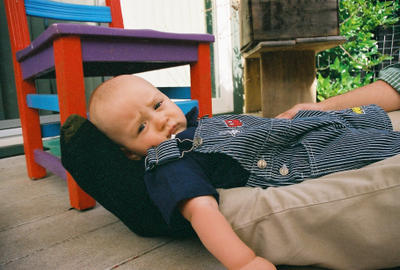
No other metaphor more aptly describes Andy's days and nights (or naps, for that matter) than Dr. Jekyll and Mr. Hide. I've just come from getting Hyde down for an afternoon nap. I'm worn and battle-scarred. Literally scarred, because he clawed across my face to get himself in the mood for sleeping. He likes to put his hands inside my mouth, run his fingernails over my teeth, and then over my lips and cheeks. He leaves scratch marks when we've let his nails grow a little too long (cutting baby's nails is another blog topic!)
Mike and I invited Andy into our bed from his birth night on. It was so heavenly then, to curl our son between us. His frequent night wakings were less disruptive, because I didn't have to fully waken and stumble to him across the hall. Sleepily, I would attach him to me and we'd both fall back to sleep.
At around three months, this arrangement stopped being much fun. Andy learned to squirm and kick. We brought his co-sleeper into the other room, and tried starting his nights there. Still needing to nurse as often as six times a night, he didn't last in his own room longer than 1 or 2 am. Too tired to keep walking down the hall, I'd bring him back to our bed. Then I'd tire of the transition altogether and he'd start the night again with us. It was easiest that way.
At nine months I bought a crib. Unlike the expecting couples I saw lingering the aisles at Baby Super, dreamily shopping for the perfect match to their nursery, I pointed to a basic wooden crib and told the salesperson "That one will do." The act of buying the crib felt a bit like losing my religion. I was slipping away from my ideal of "The Family Bed", a wonderful practice used around the world, that just wasn't working for us. After reading the following passage before his birth, I was convinced that we wouldn't buy a crib:
"The practice of sending newborns from the womb to the solitude of the crib is unique to modern Western culture. There is a story that Margaret Mead, the anthropoligist, was asked by Somoan mothers if it was true that American mothers "make their babies sleep in cages at night." Imagine the experience from the newborn's point of view, and you can see why these mothers were so bewildered by our use of cribs. Unaware even that he is a separate person from his mother, the baby finds himself without her in the vast, still openness of a crib. His instincts tell him it is dangerous to be alone in the dark, away from people and where wolves might find him. Utterly helpless, he panics. No wonder babies cry at night." (Gale Pryor from Nursing Mother, Working Mother.)
This is a case in point where I read way, way too much during pregnancy. Mentioning wolves, danger, cages, and panic in one paragraph is quite inflammatory, especially to a pregnant woman. "Feed my baby to wolves in his own room??" That was the single passage that convinced me to try sharing sleep with Andy. Gale Pryor, Dr. Sears, La Leche League, and other attachment advocates formed my non-western childrearing canon.
But why didn't Dr. Sears talk about what to do when your newborn is no longer a newborn, but an active 8, 9, 10 month old who is crawling to the edge of the bed, grabbing lamps from the nightstands? When I wake up to find my child lying horizontally between us, his feet in my face?
Well, maybe I'll write more later. Dr. Jeckyll has woken from his nap.
No comments:
Post a Comment